 W
WThe black-browed bushtit or black-browed tit is a species of bird in the family Aegithalidae. It is found in mid-southern China and sporadically in Myanmar. Its natural habitats are boreal forests and temperate forests. It was formerly considered conspecific with the rufous-fronted tit of the central and eastern Himalayas but is now often regarded as a separate species. Sometimes the subspecies A. b. sharpei of western Burma is also treated as a species.
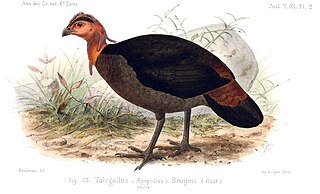 W
WThe Waigeo brushturkey or Bruijn's brushturkey is a large brownish-black megapode with a bare red facial skin, red comb, maroon rump and chestnut brown below. There are two elongated red wattles on the back of the head and a long wattle on the foreneck. Both sexes are similar. The female has a smaller comb and no wattles.
 W
WHumblot's sunbird is a species of bird in the family Nectariniidae. It is endemic to the islands of Grand Comoro and Mohéli in the Comoros.
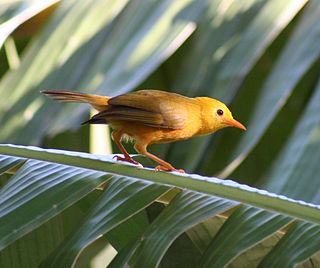 W
WThe golden white-eye is a species of bird in the white-eye family, Zosteropidae. It is the only species within the genus Cleptornis. The golden white-eye was once considered to be a honeyeater in the family Meliphagidae and although it is now known to be a white-eye, its position within that family is still uncertain. The species is restricted to the islands of Saipan and Aguijan in the Northern Mariana Islands, where it is sympatric and competes with the related bridled white-eye. The golden white-eye has golden plumage and a pale eye-ring. It feeds on insects, fruit, and nectar and forages in pairs or small family groups. The bird is monogamous and lays two eggs in a small cup nest.
 W
WThe giant ibis, the only species in the monotypic genus Thaumatibis, is a wading bird of the ibis family, Threskiornithidae. It is confined to northern Cambodia, with a few birds surviving in extreme southern Laos and a recent sighting in Yok Đôn National Park, Vietnam.
 W
WThe golden white-eye is a species of bird in the white-eye family, Zosteropidae. It is the only species within the genus Cleptornis. The golden white-eye was once considered to be a honeyeater in the family Meliphagidae and although it is now known to be a white-eye, its position within that family is still uncertain. The species is restricted to the islands of Saipan and Aguijan in the Northern Mariana Islands, where it is sympatric and competes with the related bridled white-eye. The golden white-eye has golden plumage and a pale eye-ring. It feeds on insects, fruit, and nectar and forages in pairs or small family groups. The bird is monogamous and lays two eggs in a small cup nest.
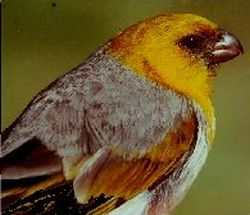 W
WLoxioides is a genus of Hawaiian honeycreeper, in the subfamily Carduelinae.
 W
WThe subdesert mesite is a ground-dwelling bird endemic to Madagascar. It is one of three species in the mesite family Mesitornithidae, and is restricted in distribution to a small low-land region in southwest Madagascar.
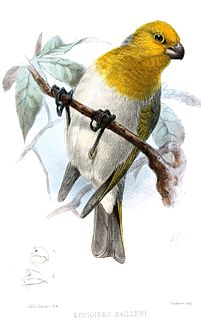 W
WThe palila is a critically endangered finch-billed species of Hawaiian honeycreeper. It has a golden-yellow head and breast, with a light belly, gray back, and greenish wings and tail. The bird has a close ecological relationship with the māmane tree, and became endangered due to destruction of the trees and accompanying dry forests. The first specimen of the palila was collected in 1876 at the Greenwell Ranch on the Big Island by Pierre Étienne Théodore Ballieu (1828–1885), who was French consul in Hawai‘i from 1869 to 1878. The type specimen is housed at the Muséum national d'histoire naturelle in Paris.
 W
WEdwards's pheasant is a bird of the pheasant family Phasianidae and is endemic to the rainforests of Vietnam. It is named after the French ornithologist Alphonse Milne-Edwards and first described to science in 1896 The bird's length is 58–65 centimetres (23–26 in) and has red legs and facial skin. The male is mainly blue-black with a crest, and the female is a drab brown bird. The alarm call is a puk!-puk!-puk!.
 W
WThe Tibetan snowfinch or Henri's snowfinch is a species of bird in the sparrow family.
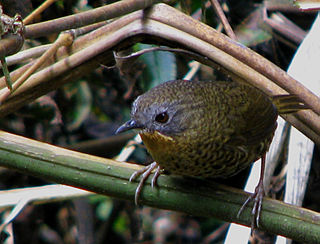 W
WSpelaeornis, the typical wren-babblers, is a bird genus in the family Timaliidae. Among this group, the typical wren-babblers are quite closely related to the type species, the chestnut-capped babbler. One species that was earlier placed in the genus, the spotted elachura has been removed to a genus of its own Elachura and placed in a separate family.